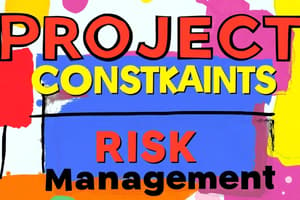Podcast
Questions and Answers
Which conflict-handling method is characterized by assertiveness and uncooperativeness?
Which conflict-handling method is characterized by assertiveness and uncooperativeness?
- Collaborating
- Compromising
- Competing (correct)
- Avoiding
What is the key characteristic of the collaborating conflict-handling method?
What is the key characteristic of the collaborating conflict-handling method?
- It involves avoiding discussion of the issues.
- It focuses on quick, mutually acceptable solutions.
- It aims for a solution that satisfies both parties. (correct)
- It seeks a solution that satisfies one party's concerns.
What does accommodating primarily involve in a conflict resolution context?
What does accommodating primarily involve in a conflict resolution context?
- Avoiding the conflict altogether.
- Prioritizing one's own needs over others.
- Finding a compromise that benefits all parties.
- Neglecting personal concerns to satisfy the other person's needs. (correct)
Which conflict-handling method is seen as unassertive and uncooperative?
Which conflict-handling method is seen as unassertive and uncooperative?
Which of the following best describes the 'collaboration' conflict resolution style?
Which of the following best describes the 'collaboration' conflict resolution style?
Compromising in conflict management aims to achieve what?
Compromising in conflict management aims to achieve what?
What is a similarity between compromising and accommodating?
What is a similarity between compromising and accommodating?
What does accommodating typically involve in a conflict situation?
What does accommodating typically involve in a conflict situation?
In which scenario is the accommodating style most likely to be employed?
In which scenario is the accommodating style most likely to be employed?
What underlying element is crucial in the accommodating approach to conflict resolution?
What underlying element is crucial in the accommodating approach to conflict resolution?
What is the primary focus of the Integrative conflict approach?
What is the primary focus of the Integrative conflict approach?
Which conflict approach involves pushing one's viewpoint at the expense of others?
Which conflict approach involves pushing one's viewpoint at the expense of others?
What does BATNA stand for in negotiation contexts?
What does BATNA stand for in negotiation contexts?
Which strategy is emphasized for managing conflict effectively according to PMBok?
Which strategy is emphasized for managing conflict effectively according to PMBok?
Which of the following characterizes a withdraw/avoid approach to conflict?
Which of the following characterizes a withdraw/avoid approach to conflict?
What should a project manager understand to minimize conflict in negotiation?
What should a project manager understand to minimize conflict in negotiation?
Which of the following actions could result from a failed negotiation?
Which of the following actions could result from a failed negotiation?
How can a project manager effectively negotiate peace among conflicting parties?
How can a project manager effectively negotiate peace among conflicting parties?
What is a correct definition of power in the context of project management?
What is a correct definition of power in the context of project management?
Which statement best describes influence in project management?
Which statement best describes influence in project management?
Conflict can only have dysfunctional aspects and never functional ones.
Conflict can only have dysfunctional aspects and never functional ones.
Interpersonal conflict occurs between individuals.
Interpersonal conflict occurs between individuals.
One source of conflict in projects is competition for resources.
One source of conflict in projects is competition for resources.
Dysfunctional conflict can lead to decreased job satisfaction.
Dysfunctional conflict can lead to decreased job satisfaction.
Beliefs and value systems are often hidden during conflicts.
Beliefs and value systems are often hidden during conflicts.
Competing is characterized by being assertive and cooperative.
Competing is characterized by being assertive and cooperative.
Compromising aims to find a solution that fully satisfies both parties.
Compromising aims to find a solution that fully satisfies both parties.
Avoiding involves addressing the conflict directly and assertively.
Avoiding involves addressing the conflict directly and assertively.
Collaborating seeks to identify underlying concerns to find a creative solution.
Collaborating seeks to identify underlying concerns to find a creative solution.
Accommodating is a cooperative method that might require giving up one's own concerns.
Accommodating is a cooperative method that might require giving up one's own concerns.
The Distributive approach to conflict is characterized by a win-win outcome.
The Distributive approach to conflict is characterized by a win-win outcome.
BATNA stands for Best Alternative To a Negotiated Agreement.
BATNA stands for Best Alternative To a Negotiated Agreement.
An integrative conflict approach focuses primarily on short-term outcomes rather than long-term relationships.
An integrative conflict approach focuses primarily on short-term outcomes rather than long-term relationships.
The Smooth/Accommodate method highlights areas of disagreement to resolve conflicts.
The Smooth/Accommodate method highlights areas of disagreement to resolve conflicts.
Withdrawing from a conflict situation is considered an assertive approach to conflict management.
Withdrawing from a conflict situation is considered an assertive approach to conflict management.
What are two functional aspects of conflict that can benefit a team?
What are two functional aspects of conflict that can benefit a team?
Name one source of conflict related to communication within project teams.
Name one source of conflict related to communication within project teams.
What type of conflict involves disagreements between different departments or divisions?
What type of conflict involves disagreements between different departments or divisions?
How might differences in values and interests contribute to conflict in a project?
How might differences in values and interests contribute to conflict in a project?
What is one effective strategy for resolving conflict that project managers should employ?
What is one effective strategy for resolving conflict that project managers should employ?
Conflict is a process that involves people ______.
Conflict is a process that involves people ______.
Sources of conflict can include competition for ______, time, and money.
Sources of conflict can include competition for ______, time, and money.
Functional aspects of conflict can help set organizational ______.
Functional aspects of conflict can help set organizational ______.
Dysfunctional conflict can lead to reduced job ______ and increased turnover.
Dysfunctional conflict can lead to reduced job ______ and increased turnover.
Types of conflict include intrapersonal, interpersonal, and ______ conflict.
Types of conflict include intrapersonal, interpersonal, and ______ conflict.
Flashcards
Competing
Competing
A conflict-handling style that prioritizes satisfying one's own concerns, often at the expense of the other person's. It often uses power to achieve one's objectives.
Collaborating
Collaborating
A conflict-handling style that focuses on finding a solution that satisfies the concerns of all parties. It requires a thorough understanding of both sides' needs.
Compromising
Compromising
A conflict-handling style that seeks a middle-ground solution that partially satisfies both parties. It involves give-and-take.
Avoiding
Avoiding
Signup and view all the flashcards
Accommodating
Accommodating
Signup and view all the flashcards
Lose-Lose Conflict Style
Lose-Lose Conflict Style
Signup and view all the flashcards
Win-Lose Approach
Win-Lose Approach
Signup and view all the flashcards
Withdraw/Avoid Conflict Style
Withdraw/Avoid Conflict Style
Signup and view all the flashcards
Smooth/Accommodate Conflict Style
Smooth/Accommodate Conflict Style
Signup and view all the flashcards
BATNA - Best Alternative to a Negotiated Agreement
BATNA - Best Alternative to a Negotiated Agreement
Signup and view all the flashcards
What is power?
What is power?
Signup and view all the flashcards
What is influence?
What is influence?
Signup and view all the flashcards
Sources of Power
Sources of Power
Signup and view all the flashcards
Influence Styles
Influence Styles
Signup and view all the flashcards
Power and Influence in PM
Power and Influence in PM
Signup and view all the flashcards
Conflict
Conflict
Signup and view all the flashcards
Sources of Conflict in Projects
Sources of Conflict in Projects
Signup and view all the flashcards
Functional Conflict
Functional Conflict
Signup and view all the flashcards
Dysfunctional Conflict
Dysfunctional Conflict
Signup and view all the flashcards
Types of Conflict
Types of Conflict
Signup and view all the flashcards
Assertiveness
Assertiveness
Signup and view all the flashcards
Cooperativeness
Cooperativeness
Signup and view all the flashcards
Competing Style
Competing Style
Signup and view all the flashcards
Collaborating Style
Collaborating Style
Signup and view all the flashcards
Compromising Style
Compromising Style
Signup and view all the flashcards
Force/Direct Conflict Style
Force/Direct Conflict Style
Signup and view all the flashcards
Distributive Negotiation
Distributive Negotiation
Signup and view all the flashcards
Integrative Negotiation
Integrative Negotiation
Signup and view all the flashcards
What is conflict?
What is conflict?
Signup and view all the flashcards
Conflict in Projects
Conflict in Projects
Signup and view all the flashcards
Study Notes
Leading Projects in an Organizational Context
- The presentation covers conflict, power, and influence in project management.
- It details conflict management strategies and how to resolve conflicts.
- BATNA is crucial in negotiations, and understanding alternatives is important.
Today's Topic: Conflict
- Conflict is defined as a process where individuals disagree.
- Common terms to describe conflict include disagreement, difference, and dispute.
- Sources of conflict in projects may include communication breakdowns, differing attitudes of reference groups, competition for resources (people, time, money), interdependencies amongst teams or lines of business, differing values, personalities and interests, differing educational backgrounds, cultures or work perceptions, and differences in goals or expectations.
Aspects of Conflict
- Functional conflict is productive. It can encourage dialogue, increase understanding, clarify values, and prompt creativity through mindful debate.
- Dysfunctional conflict reduces productivity, takes focus away from organizational goals, reduces job satisfaction, increases turnover, and causes anxiety and absenteeism.
Types of Conflict
- Intrapersonal conflict: Internal conflict (feelings of inadequacy).
- Interpersonal conflict: Conflict between people.
- Intergroup conflict: Conflict amongst departments or divisions.
Conflict Management
- Conflict is a natural part of work and life.
- Project managers should guide their teams in establishing norms and agreements to manage conflicts.
- Techniques to agree on disagreements & move on from disagreements are important.
Handling Conflict
- Conflict behavior can be described by assertiveness (satisfying personal concerns) and cooperativeness (satisfying the interests of others).
- Five modes of dealing with conflict are defined: competing, collaborating, compromising, avoiding, and accommodating.
Handling Conflict: Specific Strategies
- Competing: Assertive, uncooperative. Pursues one's own interests at the expense of others.
- Collaborating: Assertive and cooperative; seeks solutions to satisfy the concerns of both parties.
- Compromising: Intermediate in assertiveness and cooperativeness; finds mutually acceptable solutions that partially satisfy both parties.
- Avoiding: Unassertive and uncooperative; doesn't immediately pursue concerns of oneself or others. Postpones or avoids conflict.
- Accommodating: Unassertive and cooperative; neglects one's own concerns to satisfy others' concerns.
Handling Conflict (Negotiation): Different Approaches
- Collaborate/Problem Solve: Incorporates multiple viewpoints (Win-Win).
- Compromise/Reconcile: Seeks solutions that give some satisfaction to all parties (Lose-Lose).
- Force/Direct: Pushing one's perspective at the expense of others; commonly enforced via power (Win-Lose).
- Withdraw/Avoid: Retreating from conflict; postponing (Lose-Lose).
- Smooth/Accommodate: Highlighting areas of agreement; downplaying differences (Lose-Lose).
Distributive vs. Integrative Approaches
- Distributive: Win-Lose approach with fixed resources.
- Integrative: Win-Win approach; not a zero-sum game; focused on long-term relationships.
Conflict Simple Strategy
- Maintain open, respectful communication.
- Focus on issues, not personalities.
- Focus on the present and future.
- Search for alternatives jointly.
BATNA (Best Alternative to a Negotiated Agreement)
- Crucial in negotiations. Know your alternatives.
- Understand the other party's circumstances and limits.
Negotiation
- Choose representatives (neutral parties) and mediator if necessary.
- Understand relationships, communication styles, organizational cultures, and bargaining perspectives.
Results of Failed Negotiations
- Alliances outside negotiations, often with competitors.
- Invoking silent authorities within the organization (CEO, Leadership Team).
- Threatening legal action or job action.
- Walking away from deals.
Summary of Conflict
- Conflict is normal.
- Excellent project managers communicate clearly, respect values, and seek solutions for mutual gain.
- Understanding causes and facilitating communication and understanding are fundamental.
Organizational Power and Influence
- Organizational structure impacts power and influence.
- Power is the capacity to affect others' actions; tactics are involved.
- Influence is the process of persuading followers.
Source of Power
- Expert: Knowledge/experience.
- Referent: Trust/respect developed over time.
- Legitimate: Authority.
- Information: Possession of valuable information.
- Charismatic: Personal appeal.
- Reward: Ability to grant rewards.
- Coercive: Ability to inflict penalties.
- Location: Higher status/position; important in organizations.
- Timing: Availability, opportunity, and timeliness in decision-making
Empowering to Gain Power
- The more powerful a leader is, the more power they empower their team with.
- Trust and confidence engender team accomplishment.
- Establish clear communication pathways
Influence Tactics
- Rational persuasion: Logic and reasoning.
- Inspirational appeals: Appeals to shared values/ideals
- Consultation: Inputs from others.
- Ingratiation: Appealing to a person's ego.
- Exchange: Bartering/trading.
- Coalition tactics: Joining with others.
Influencing Styles
- Assertive persuasion: Reasoning and debating.
- Reward and punishment: Demanding expectations and offering incentives/pressures.
- Participation and trust: Empathy, understanding, involving others.
- Common vision: Establishing shared vision.
Influence Responses
- Commitment: Active support for the request.
- Compliance: Obedience to the request, but not necessarily full backing.
- Resistance: Passive or active rejection.
Influencing Strategies
- Establishes credibility (trust) with your team.
- Frames goals to find common ground.
- Uses vivid language/compelling evidence.
- Connects emotionally/relates to your audience.
Sustained Influence
- Build credibility as an expert.
- Invest in strong relationships.
- Develop networks of expertise.
- Employ influencing tactics with sensitivity and subtlety.
Strategy Building for Influencing
- Establish your objectives, "why".
- Identify who needs cooperation and what motivates/demotivates them.
- Develop and nurture crucial relationships.
- Recognize and understand your own power base.
- Understand outcomes and your comfort level with influencing.
- Communicate effectively as a Project Manager.
Summary of Influencing Tactics
- Understanding influencing tactics and how they relate to project management strategies and navigating team interactions is important.
- Power dynamics are central to all project developments.
- Ongoing learning from experience and self-reflection is essential.
Assignment: Conflict in Project Management
- Students are assigned two conflict scenarios to analyze and propose solutions, including questions like who, what, when, where, and how.
Studying That Suits You
Use AI to generate personalized quizzes and flashcards to suit your learning preferences.



